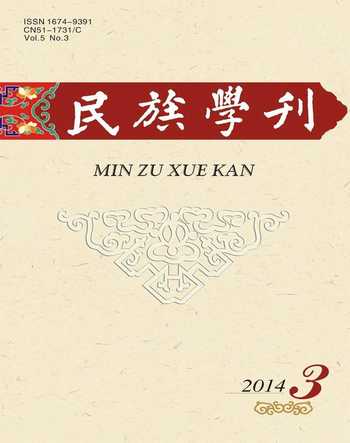Review and Reflection on the Religious Studies of the Qiang during the Past One Hundred Years
2014-04-29YUANLinrong
YUAN Linrong
Abstract:
This article reviews more than 150 articles and books which research Qiang religion,and divides research of Qiang religioninto three periods.
Ⅰ. 1910-1949: research on polytheistic beliefs
The period from 1910 to 1949 was a time during which Western anthropologists were searching for the Qiangs religious culture. Characterisitc of this period was a bias towards descriptive ethnography ; doing fieldwork related to religious culture;and describing, recording or even reconstructing Qiang religious culture.
Ⅱ. 1950-1980: a time when fieldwork related to religious customs stagnated
From 1950 to 1980, almost all the research on the Qiangs religious beliefs was based on the theoretical principle that “Religion is the opiate of the people”. We can see that all the works produced during this period illustrated this principle.
Ⅲ. 1981- 2010: a period for investigation and sorting out the white stone belief system and scriptures
1. Research on the belief system of the white stone
The representative work of this period was the Mysterious Worship of the White Stone by Wang Kang et al. in 1992. The authors transformed Qiang myths related to Heaven, Earth, nature, and hero into the origin of the religious belief system, and confirmed their social function. This provided a new way of thinking in the studies on Qiang religion. In addition, there were archaeological interpretations regarding the study of the origin of the “white stone worship”.
2) Studies on religious rituals
The Qiang between the Han and Tibetan by Wang Mingke discusses the relationship between the religious rituals and power, and the relationship between powers. It could be said that Wang Mingkes research has expanded and deepened the vision of studies on the workshop of the mountain god.
3) Studies on community religion
In the Study on Qiang History and Culture edited by Lu Ding and Gong Tengyuan, there is a chapter that specially focuses on a discussion of Qiang religious life in the Taoping community of Lixian. In looking at the content, the author did not provide a description of the collective religious activities. Moreover, the book did not mention anything about the stability and change of the religious activities after the 1950s, nor did it explain how much or what part of traditional religious features were still preserved by the Qiang.
4) Commercialization of white stone worship
The Review of Qiang Religious Studies by Ma Ning and Qian Yongping considers the many tourism companies that hire Qiang shamans to engage in the religious activities in order to attract tourists in the 21st century. Although the income of the shamans increased, their social prestige was reduced. Wang Mingke gives another interpretation on this phenomenon by using functionalism in his book titled the Qiang between the Han and Tibetan.
5)Investigating and sorting out religious scriptures
The most prominent research on Qiang religion during this period was made by Qian Anjing from Sichuan University. Based on the foundation built by Hu Jianming, Qian restarted collecting and sorting out the Qiangs primitive religious scriptures and rituals, and, in doing so, he made a lot of contributions in this field.
Key Words: the Qiang; religious research; white stone belief; primitive religion
References:
Chen fanzhou.jianfangqian qiangzu yuanshi zongjiao zhi guanjian(The Primitive Religion Pre-Liberation)[J].Journal of Southwest University for Nationalities,1981(1).
David Crockett Graham. qiangming de zongjiao ( The Religion of the Ch'iang)[J].Sun Jiajian,transl. The Frontier Service,1946(15).
—.qiangzu fengsu: sichuan minjiang shangyou lishi wenhua yanjiu (The Customs of the Ch'iang)[M]. Xu Jun, transl.Chengdu: sichuan daxue chubanshe,1996.
—. qiangzu de xisu yu zongjiao: geweihan minzuxue kaoguxue lunzhu(The Customs and Religion of the Ch'iang)[M].Geng Jing,transl. Chengdu:bashu shushe,2004.
Fan Wenhai. qiangqu lvxingji(Travelogue about the Qiang Area)[J].Frontier Service,1948(25).
Hu Jianmin. qiangzu de xingyan yu xiwei(The Belief and Behavior of the Qiang)[M].bianjiang yanjiu luncong,1941.
—.qiangzu de jingji huoding xingshi(The Economic Activities Type of the Qiang)[J]. Series of Ethnology Studies,1944(4).
Li Zhicun,et al. erma(qiangzu)qingkuang (About Erma[the Qiang])[M].xinan minzu xueyuan yanjiushi,1954.
Lu Ding, Gongteng Yuannan. qiangzu lishi wenhua yanjiu(The Study on Qiang History and Culture)[M]. Chengdu:sichuan renmin chubanshe,2000.
Lu Yu. xianhua qiangmin(Talks on the Qiang)[J].Frontier Service,1945(8).
Ma Ning,Qian Yongping. qiangzu zongjiao yanjiu zongshu(The Review of Qiang Religious Studies)[J].Guizhou Ethnic Studies,2008(4).
Mongolian and Tibetan Division of the Education Ministry. chuanxi diaochaji(Investigation Records from the West Sichuan)[M].1943.
Qian Anjing. qiangzu zongjiao xisu diaocha ziliao:qiangzu shehui lishi diaocha(Investigation Data on the Qiang's Religion and Customs: Investigation on the Qiang's Social History)[M].Chengdu:sichuansheng shehui kexueyuan chubanshe,1986.
—.qiangzu zongjiao xisu diaocha size (Investigation on the Qiang's Religion and Customs)[J]. Religious Studies,1987(3).
—.qiangzu wushi jingdian size:zongjiaoxue yanjiu lunji(The Qiang Shamans' Ritual: A Collection of Thesis on Religious Studies)[J]. Series of Sichuan University,1985(25).
—.qiangzu juan:zhongguo yuanshi zongjiao ziliao congbian(Series of China' s Primitive Religion: The Qiang Volume)[M].Shanghai: shanghai renmin chubanshe,1993.
Rev.Thomas. Torrance. qiangzu de lishi, xisu he zongjiao (The History, Customs and Religion of the Ch'iang)[M]. Chen Huisi,transl. wenchuanxian dang'an guan,1987.
Shen Zhongchang.cong kaogu ziliao kan qiangzu baishi congbai yisu(Seeing the Qiang's White Stone Worship Custom from the Archaeological Data)[J].Archaeology and Cultural Relics,1982(6).
Wang Kang et al. shengmi de baishi congbai(The Mysterious Worship of the White Stone)[M].Chengdu:sichuan minzu chubanshe,1992.
Wang Mingke.qiang zai han zang zhijian (The Qiang between the Han and Tibetan)[M].Beijing:zhonghua shuju,2008.
Xu Ming.qiangzu baishishen xingyang jianxi(An Analysis on the Qiang's White Stone Belief)[J].Journal of Southwest University for Nationalities,1999(3).
Yu Shiyu. heishui minfeng(Customs in Heishui)[J]. Kangdao Monthly,1945(6).
Zeng Wenqiong.qiangzu yuanshi zongjiao kaolue.(About the Qiang's Primitive Religion)[J].World Religions Studies,1981(2).
Zhang Zongnan. luobuzhai qiangmin de duangong (Duangong of the Qiang in Luobuzhai Village)[J]. Frontier Service,1943(2).
